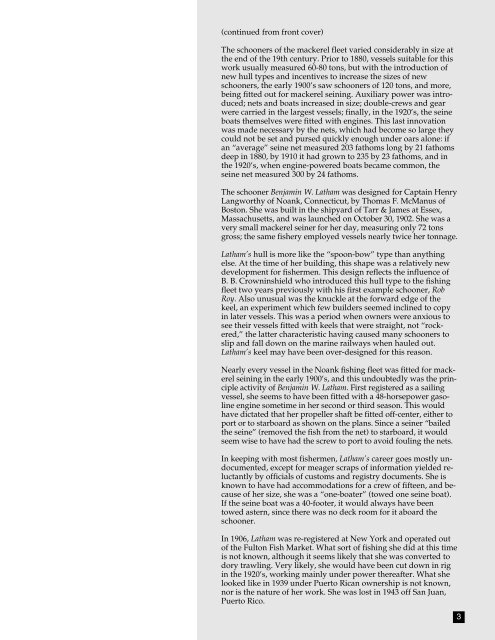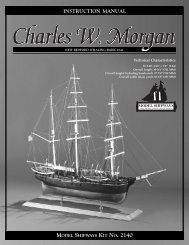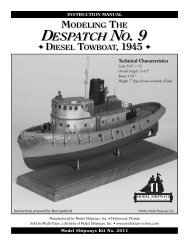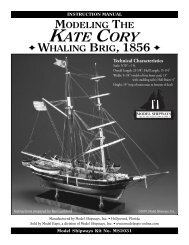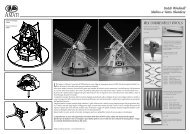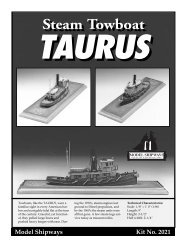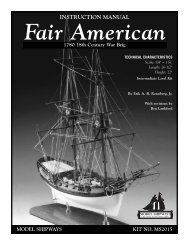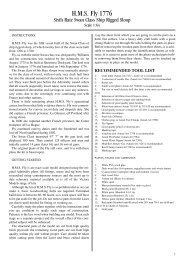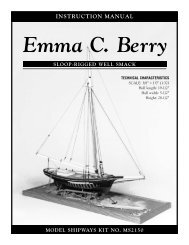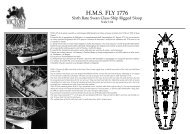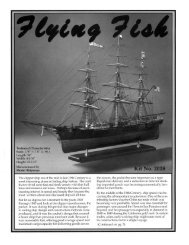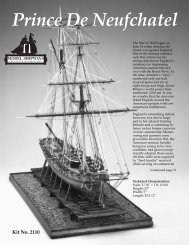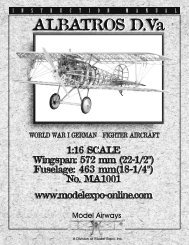download benjamin latham instruction manual
download benjamin latham instruction manual
download benjamin latham instruction manual
Create successful ePaper yourself
Turn your PDF publications into a flip-book with our unique Google optimized e-Paper software.
(continued from front cover)<br />
The schooners of the mackerel fleet varied considerably in size at<br />
the end of the 19th century. Prior to 1880, vessels suitable for this<br />
work usually measured 60-80 tons, but with the introduction of<br />
new hull types and incentives to increase the sizes of new<br />
schooners, the early 1900’s saw schooners of 120 tons, and more,<br />
being fitted out for mackerel seining. Auxiliary power was introduced;<br />
nets and boats increased in size; double-crews and gear<br />
were carried in the largest vessels; finally, in the 1920’s, the seine<br />
boats themselves were fitted with engines. This last innovation<br />
was made necessary by the nets, which had become so large they<br />
could not be set and pursed quickly enough under oars alone: if<br />
an “average” seine net measured 203 fathoms long by 21 fathoms<br />
deep in 1880, by 1910 it had grown to 235 by 23 fathoms, and in<br />
the 1920’s, when engine-powered boats became common, the<br />
seine net measured 300 by 24 fathoms.<br />
The schooner Benjamin W. Latham was designed for Captain Henry<br />
Langworthy of Noank, Connecticut, by Thomas F. McManus of<br />
Boston. She was built in the shipyard of Tarr & James at Essex,<br />
Massachusetts, and was launched on October 30, 1902. She was a<br />
very small mackerel seiner for her day, measuring only 72 tons<br />
gross; the same fishery employed vessels nearly twice her tonnage.<br />
Latham’s hull is more like the “spoon-bow” type than anything<br />
else. At the time of her building, this shape was a relatively new<br />
development for fishermen. This design reflects the influence of<br />
B. B. Crowninshield who introduced this hull type to the fishing<br />
fleet two years previously with his first example schooner, Rob<br />
Roy. Also unusual was the knuckle at the forward edge of the<br />
keel, an experiment which few builders seemed inclined to copy<br />
in later vessels. This was a period when owners were anxious to<br />
see their vessels fitted with keels that were straight, not “rockered,”<br />
the latter characteristic having caused many schooners to<br />
slip and fall down on the marine railways when hauled out.<br />
Latham’s keel may have been over-designed for this reason.<br />
Nearly every vessel in the Noank fishing fleet was fitted for mackerel<br />
seining in the early 1900’s, and this undoubtedly was the principle<br />
activity of Benjamin W. Latham. First registered as a sailing<br />
vessel, she seems to have been fitted with a 48-horsepower gasoline<br />
engine sometime in her second or third season. This would<br />
have dictated that her propeller shaft be fitted off-center, either to<br />
port or to starboard as shown on the plans. Since a seiner “bailed<br />
the seine” (removed the fish from the net) to starboard, it would<br />
seem wise to have had the screw to port to avoid fouling the nets.<br />
In keeping with most fishermen, Latham’s career goes mostly undocumented,<br />
except for meager scraps of information yielded reluctantly<br />
by officials of customs and registry documents. She is<br />
known to have had accommodations for a crew of fifteen, and because<br />
of her size, she was a “one-boater” (towed one seine boat).<br />
If the seine boat was a 40-footer, it would always have been<br />
towed astern, since there was no deck room for it aboard the<br />
schooner.<br />
In 1906, Latham was re-registered at New York and operated out<br />
of the Fulton Fish Market. What sort of fishing she did at this time<br />
is not known, although it seems likely that she was converted to<br />
dory trawling. Very likely, she would have been cut down in rig<br />
in the 1920’s, working mainly under power thereafter. What she<br />
looked like in 1939 under Puerto Rican ownership is not known,<br />
nor is the nature of her work. She was lost in 1943 off San Juan,<br />
Puerto Rico.<br />
3


